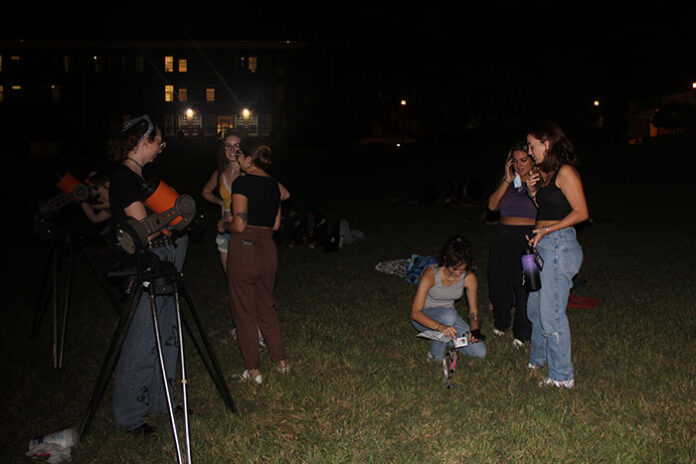
Salvatore Ambrosino
Features Editor
Alanya Nardone says she’s loved the stars her entire life.
“I have always liked space ever since I was a kid, especially with science fiction movies. Specifically, I love stars and the star cycle because it is so cool how they transition and how long they live,” Nardone said.
Nardone is the president of the Astronomy Club. She and her club mates, with their big orange telescopes and binoculars, meet only in the night, viewing distant planets and stars at a closeup.
When the conditions in the sky are good—a clear, starry night—they’ve been able to see Venus, as well as Jupiter and its moons. When the conditions have been at their best, they’ve even achieved a visual of Saturn.
“I wanted to learn more about space and learn to use telescopes, once I learned we had an astronomy club on campus,” Nardone said. “We have access to telescopes and binoculars to allow our peers to learn how to use the telescopes.”
The group organizes speaker events, movie nights in the newly refinished Frank Lloyd Wright-designed planetarium, and on Friday, they will host their latest stargazing event on the roof of Polk Science.
“We wanted to provide an outlet for students and those interested in learning about the universe,” Nardone said. “It’s a club that is both informative and social. A way for many people from different backgrounds to get together and enjoy the many wonders our universe has to offer.”
The last event was held in September, on Mr. George’s Green.
To view the stars, these students use the binoculars available, but for the far-off planets in the solar system, they practice operating telescopes thousands of times more powerful than the human eye.
Venus and Jupiter are the most popular destinations at which to point the telescopes.
Jupiter appears bluish and yellow, you can see the planet’s stripes, a few of its moons. Venus is a bright planet, closely resembling a star.
With the right weather, Saturn can be barely made out as a distant dot in the sky, and much like Venus, closely resembles a star.
To solve this, Nardone hopes to acquire newer, more powerful lenses for the club’s viewings. With upgrades in equipment, the club would have better visuals on Venus, Jupiter and Saturn, as well as be able to view additional planets.
“Trying our best to focus on any [planets] that are visible,” Nardone said. “It all depends on the weather.”
Although the weather prediction is cloudy, the club looks forward to its next event.
In the past, the group has watched blood-moons, a well-known and visible phenomenon of light appearing on the surface of the moon, turning it to hues of dark orange and red.
On Friday morning, a total lunar eclipse is due. It is predicted to be the longest-lasting lunar eclipse in 600 years.
Editor’s note: Features editor Salvatore Ambrosino wrote the article based on the content and interviews provided by Diego de Jesus.







